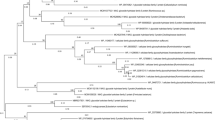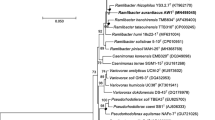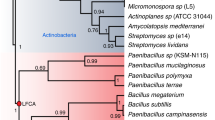Key Points
-
Cellulose from plant cell wall components can be broken down by specialized enzymes, which are primarily found in cellulolytic microorganisms.
-
The main types of cellulase can be classified into endoglucanases and exoglucanases, although oxidative enzymes can also participate. These enzymes are often modular.
-
An analysis of ∼1,500 bacterial genomes listed in the Carbohydrate-Active Enzyme (CAZy) database shows that 38% of all sequenced bacterial genomes contain at least one enzyme involved in cellulose cleavage.
-
The bacteria that encode one cellulase or more can be divided into four categories: saprophytes that do not synthesize cellulose, cellulose-synthesizing saprophytes, cellulose-synthesizing non-saprophytes and those that are neither saprophytic nor cellulose producing.
-
The role of bacterial cellulases therefore appears to be far more diversified than simply breaking down plant cell wall cellulose.
Abstract
Cellulolytic enzymes have been the subject of renewed interest owing to their potential role in the conversion of plant lignocellulose to sustainable biofuels. An analysis of ∼1,500 complete bacterial genomes, presented here, reveals that ∼40% of the genomes of sequenced bacteria encode at least one cellulase gene. Most of the bacteria that encode cellulases are soil and marine saprophytes, many of which encode a range of enzymes for cellulose hydrolysis and also for the breakdown of the other constituents of plant cell walls (hemicelluloses and pectins). Intriguingly, cellulases are present in organisms that are usually considered as non-saprophytic, such as Mycobacterium tuberculosis, Legionella pneumophila, Yersinia pestis and even Escherichia coli. We also discuss newly emerging roles of cellulases in such non-saprophytic organisms.
This is a preview of subscription content, access via your institution
Access options
Subscribe to this journal
Receive 12 print issues and online access
$209.00 per year
only $17.42 per issue
Buy this article
- Purchase on Springer Link
- Instant access to full article PDF
Prices may be subject to local taxes which are calculated during checkout




Similar content being viewed by others
References
Chavez-Munguia, B. et al. Ultrastructure of cyst differentiation in parasitic protozoa. Parasitol. Res. 100, 1169–1175 (2007).Article
Matthysse, A. G. et al. A functional cellulose synthase from ascidian epidermis. Proc. Natl Acad. Sci. USA 101, 986–991 (2004).Article
Tomlinson, G., Jones, E. A. & Kahne, D. Isolation of cellulose from the cyst of a soil amoeba. Biochim. Biophs. Acta 63, 194–200 (1962).Article
Lynd, L. R., Weimer, P. J., van Zyl, W. H. & Pretorius, I. S. Microbial cellulose utilization: fundamentals and biotechnology. Microbiol. Mol. Biol. Rev. 66, 506–577 (2002).
Somerville, C. et al. Toward a systems approach to understanding plant cell walls. Science 306, 2206–2211 (2004).
Nishiyama, Y., Langan, P. & Chanzy, H. Crystal structure and hydrogen-bonding system in cellulose Iβ from synchrotron X-ray and neutron fiber diffraction. J. Am. Chem. Soc. 124, 9074–9082 (2002).
Nishiyama, Y., Sugiyama, J., Chanzy, H. & Langan, P. Crystal structure and hydrogen bonding system in cellulose Iα from synchrotron X-ray and neutron fiber diffraction. J. Am. Chem. Soc. 125, 14300–14306 (2003).
Yarbrough, J. M., Himmel, M. E. & Ding, S. Y. Plant cell wall characterization using scanning probe microscopy techniques. Biotechnol. Biofuels 2, 17 (2009).Article
Herve, C. et al. Carbohydrate-binding modules promote the enzymatic deconstruction of intact plant cell walls by targeting and proximity effects. Proc. Natl Acad. Sci. USA 107, 15293–15298 (2010).Article
Himmel, M. E. et al. Biomass recalcitrance: engineering plants and enzymes for biofuels production. Science 315, 804–807 (2007).
Atsumi, S., Higashide, W. & Liao, J. C. Direct photosynthetic recycling of carbon dioxide to isobutyraldehyde. Nature Biotech. 27, 1177–1180 (2009).
Doi, R. H. & Kosugi, A. Cellulosomes: plant-cell-wall-degrading enzyme complexes. Nature Rev. Microbiol. 2, 541–551 (2004).
Cantarel, B. L. et al. The Carbohydrate-Active EnZymes database (CAZy): an expert resource for glycogenomics. Nucleic Acids Res. 37, D233–D238 (2009).
Henrissat B. A classification of glycosyl hydrolases based on amino acid sequence similarities. Biochem. J. 280, 309–316 (1991).
Varrot, A. et al. Mycobacterium tuberculosis strains possess functional cellulases. J. Biol. Chem. 280, 20181–20184 (2005).Article
Mba Medie, F., Ben Salah, I., Drancourt, M. & Henrissat, B. Paradoxical conservation of a set of three cellulose-targeting genes in Mycobacterium tuberculosis complex organisms. Microbiology 156, 1468–1475 (2010).Article
Mba Medie, F., Vincentelli, R., Drancourt, M. & Henrissat, B. Mycobacterium tuberculosis Rv1090 and Rv1987 encode functional β-glucan-targeting proteins. Protein Expr. Purif. 75, 172–176 (2011).Article
Pearce, M. M. & Cianciotto, N. P. Legionella pneumophila secretes an endoglucanase that belongs to the family-5 of glycosyl hydrolases and is dependent upon type II secretion. FEMS Microbiol. Lett. 300, 256–264 (2009).Article
Wong, H. C. et al. Genetic organization of the cellulose synthase operon in Acetobacter xylinum. Proc. Natl Acad. Sci. USA 87, 8130–8134 (1990).Article
Nicol, F. et al. A plasma membrane-bound putative endo-1,4-β-D-glucanase is required for normal wall assembly and cell elongation in Arabidopsis. EMBO J. 17, 5563–5576 (1998).
Henrissat, B., Driguez, H., Viet, C. & Schulein, M. Synergism of cellulase from Trichoderma reesei in the degradation of cellulose. Nature Biotech. 3, 722–726 (1985).
Olson, D. G. et al. Deletion of the Cel48S cellulase from Clostridium thermocellum. Proc. Natl Acad. Sci. USA 107, 17727–17732 (2010).Article
Vaaje-Kolstad, G. et al. An oxidative enzyme boosting the enzymatic conversion of recalcitrant polysaccharides. Science 330, 219–222 (2010).Article
Forsberg, Z. et al. Cleavage of cellulose by a CBM33 protein. Protein Sci. 20, 1479–1483 (2011).Article
Harris, P. V. et al. Stimulation of lignocellulosic biomass hydrolysis by proteins of glycoside hydrolase family 61: structure and function of a large, enigmatic family. Biochemistry 49, 3305–3316 (2010).
Quinlan, R. J. et al. Insights into the oxidative degradation of cellulose by a copper metalloenzyme that exploits biomass components. Proc. Natl Acad. Sci. USA 108, 15079–15084 (2011).Article
Vincent, F., Molin, D. D., Weiner, R. M., Bourne, Y. & Henrissat, B. Structure of a polyisoprenoid binding domain from Saccharophagus degradans implicated in plant cell wall breakdown. FEBS Lett. 584, 1577–1584 (2010).Article
Rubin, E. M. Genomics of cellulosic biofuels. Nature 454, 841–845 (2008).
Ross, P., Mayer, R. & Benziman, M. Cellulose biosynthesis and function in bacteria. Microbiol. Rev. 55, 35–58 (1991).
Zogaj, X., Nimtz, M., Rohde, M., Bokranz, W. & Romling, U. The multicellular morphotypes of Salmonella typhimurium and Escherichia coli produce cellulose as the second component of the extracellular matrix. Mol. Microbiol. 39, 1452–1463 (2001).
Matthysse, A. G., Thomas, D. L. & White, A. R. Mechanism of cellulose synthesis in Agrobacterium tumefaciens. J. Bacteriol. 177, 1076–1081 (1995).
Koo, H. M., Song, S. H., Pyun, Y. R. & Kim, Y. S. Evidence that a β-1,4-endoglucanase secreted by Acetobacter xylinum plays an essential role for the formation of cellulose fiber. Biosci. Biotechnol. Biochem. 62, 2257–2259 (1998).
Yuan, Y. et al. Crystal structure of a peptidoglycan glycosyltransferase suggests a model for processive glycan chain synthesis. Proc. Natl Acad. Sci. USA 104, 5348–5353 (2007).
Pear, J. R., Kawagoe, Y., Schreckengost, W. E., Delmer, D. P. & Stalker, D. M. Higher plants contain homologs of the bacterial celA genes encoding the catalytic subunit of cellulose synthase. Proc. Natl Acad. Sci. USA 93, 12637–12642 (1996).
Robert, S. et al. An Arabidopsis endo-1,4-β-D-glucanase involved in cellulose synthesis undergoes regulated intracellular cycling. Plant Cell 17, 3378–3389 (2005).
Molmeret, M. et al. Temporal and spatial trigger of post-exponential virulence-associated regulatory cascades by Legionella pneumophila after bacterial escape into the host cell cytosol. Environ. Microbiol. 12, 704–715 (2010).
Weissenmayer, B. A., Prendergast, J. G., Lohan, A. J. & Loftus, B. J. Sequencing illustrates the transcriptional response of Legionella pneumophila during infection and identifies seventy novel small non-coding RNAs. PLoS ONE 6, e17570 (2011).
Molmeret, M., Horn, M., Wagner, M., Santic, M. & Abu, K. Y. Amoebae as training grounds for intracellular bacterial pathogens. Appl. Environ. Microbiol. 71, 20–28 (2005).
Daniel, J., Maamar, H., Deb, C., Sirakova, T. D. & Kolattukudy, P. E. Mycobacterium tuberculosis uses host triacylglycerol to accumulate lipid droplets and acquires a dormancy-like phenotype in lipid-loaded macrophages. PLoS Pathog. 7, e1002093 (2011).
Harding, C. V. & Boom, W. H. Regulation of antigen presentation by Mycobacterium tuberculosis: a role for Toll-like receptors. Nature Rev. Microbiol. 8, 296–307 (2010).
Mba Medie, F., Ben Salah, I., Henrissat, B., Raoult, D. & Drancourt, M. Mycobacterium tuberculosis complex mycobacteria as amoeba-resistant organisms. PLoS ONE 6, e20499 (2011).
Abd, H., Saeed, A., Weintraub, A. & Sandstrom, G. Vibrio cholerae O139 requires neither capsule nor LPS O side chain to grow inside Acanthamoeba castellanii. J. Med. Microbiol. 58, 125–131 (2009).
Thomas, V., McDonnell, G., Denyer, S. P. & Maillard, J. Y. Free-living amoebae and their intracellular pathogenic microorganisms: risks for water quality. FEMS Microbiol. Rev. 34, 231–259 (2009).
Davies, G. J., Tolley, S. P., Henrissat, B., Hjort, C. & Schulein, M. Structures of oligosaccharide-bound forms of the endoglucanase V from Humicola insolens at 1.9 Å resolution. Biochemistry 34, 16210–16220 (1995).
Henrissat, B. & Davies, G. Structural and sequence-based classification of glycoside hydrolases. Curr. Opin. Struct. Biol. 7, 637–644 (1997).
Zechel, D. L. & Withers, S. G. Glycosidase mechanisms: anatomy of a finely tuned catalyst. Acc. Chem. Res. 33, 11–18 (2000).
Vocadlo, D. J. & Davies, G. J. Mechanistic insights into glycosidase chemistry. Curr. Opin. Chem. Biol. 12, 539–555 (2008).
Acknowledgements
F.M.M. was funded by La Fondation Infectiopole Sud, France. G.J.D. is a Royal Society Wolfson Research Merit Award recipient.
Author information
Authors and Affiliations
Corresponding author
Ethics declarations
Competing interests
The authors declare no competing financial interests.
Supplementary information
Supplementary information S1 (table)
The multiple combinations of modules in bacterial cellulases (PDF 158 kb)
Glossary
- Saprophytic lifestyle
-
Referring to the lifestyle of an organism that feeds on dead organic matter of plant origin.
- Xylophages
-
Organisms that feed on wood.
Rights and permissions
About this article
Cite this article
Medie, F., Davies, G., Drancourt, M. et al. Genome analyses highlight the different biological roles of cellulases. Nat Rev Microbiol 10, 227–234 (2012). https://doi.org/10.1038/nrmicro2729
Published:
Issue Date:
DOI: https://doi.org/10.1038/nrmicro2729
This article is cited by
-
Response of fungal and bacterial communities in fine root litter with different diameters to nitrogen application
Journal of Soils and Sediments (2023)
-
Isolation of Halomicroarcula pellucida strain GUMF5, an archaeon from the Dead Sea-Israel possessing cellulase
3 Biotech (2022)
-
Comparative metagenomic discovery of the dynamic cellulose-degrading process from a synergistic cellulolytic microbiota
Cellulose (2021)
-
Production and partial characterization of a crude cold-active cellulase (CMCase) from Bacillus mycoides AR20-61 isolated from an Alpine forest site
Annals of Microbiology (2020)
-
Characterization of bacterial communities associated with the pinewood nematode insect vector Monochamus alternatus Hope and the host tree Pinus massoniana
BMC Genomics (2020)



